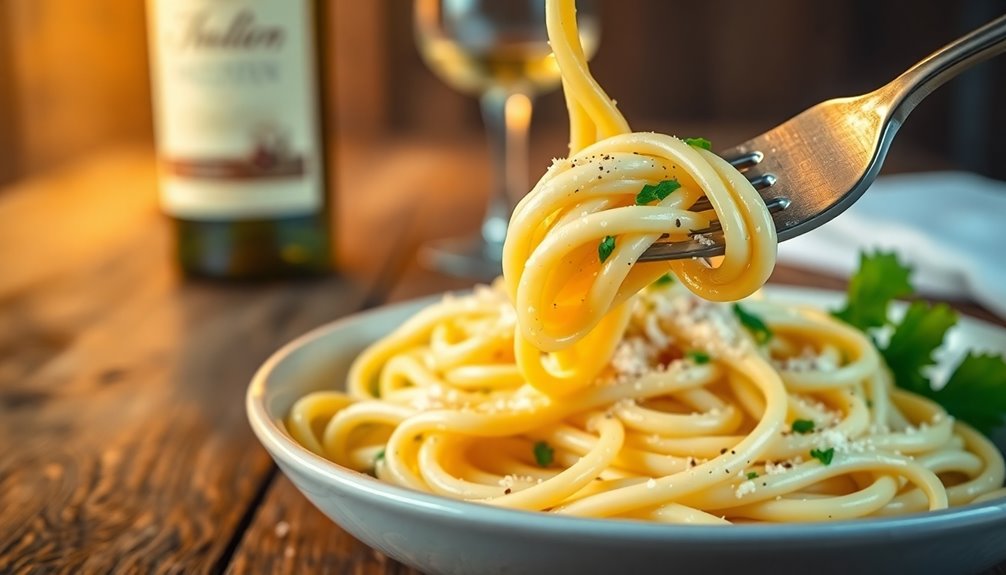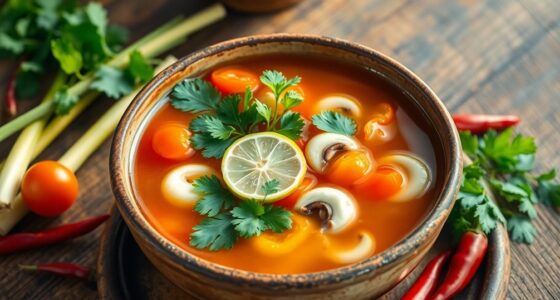Fettuccine Alfredo is a classic Roman dish that showcases the beauty of simplicity. Made with fresh egg fettuccine, unsalted butter, and Parmigiano-Reggiano, it highlights authentic Italian flavors without the need for cream or black pepper. Traditionally, it's prepared with just a few high-quality ingredients, creating a rich and creamy sauce that adheres beautifully to the pasta. If you're curious about its history, ingredients, and cooking methods, there's more to explore about this beloved Italian classic.
History
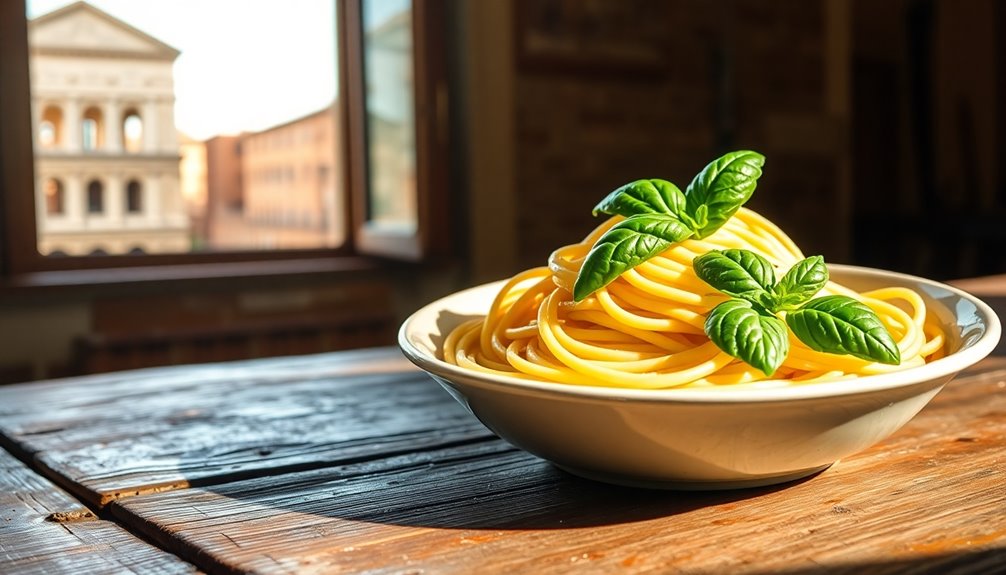
Fettuccine Alfredo has a fascinating history that dates back to the early 20th century when Alfredo Di Lelio created the dish at his trattoria in Rome to help his wife recover from childbirth.
The authentic recipe is simple, featuring just four ingredients: fettuccine, salted butter, Parmigiano-Reggiano cheese, and a touch of salt.
Unlike many modern adaptations, it contains no cream or black pepper, allowing the rich flavors of butter and cheese to shine.
Originally, the proportions were generous, with two-thirds of a cup of butter and over a quarter-pound of cheese for every pound of pasta.
This indulgent dish quickly gained fame, especially in the U.S., thanks to Hollywood's embrace, but the classic Roman style remains a cherished culinary legacy.
Recipe
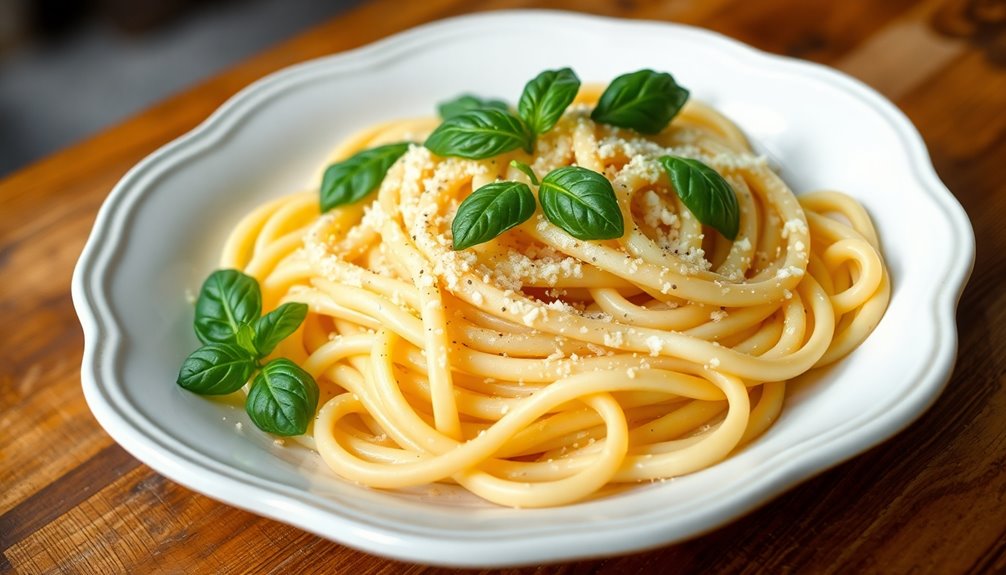
To begin, you'll need to make or procure fresh egg fettuccine noodles, as they provide the best texture and flavor for this dish. The cooking method is simple yet requires attention to detail to achieve the perfect sauce consistency.
Start with fresh egg fettuccine for the best texture and flavor, ensuring a deliciously authentic dish.
By combining the freshly cooked pasta with melted butter and grated cheese, and incorporating starchy pasta water, you'll create a creamy sauce that clings beautifully to the noodles. Follow the steps below to prepare this classic Roman dish in your own kitchen.
Ingredients
- 1 pound fresh egg fettuccine
- 2/3 cup unsalted butter
- 8 ounces aged Parmigiano-Reggiano, grated
- Salt (to taste)
- Water (for cooking pasta)
Cooking Instructions
Bring a large pot of salted water to a boil, then add the fresh fettuccine and cook until al dente, typically about 2-4 minutes depending on thickness.
While the pasta is cooking, melt the butter in a heatproof bowl set over a pot of simmering water. Once the pasta is cooked, reserve about a cup of the starchy pasta water, then drain the fettuccine and immediately transfer it to the bowl with the melted butter.
Add the grated Parmigiano-Reggiano and toss vigorously, incorporating the reserved pasta water a little at a time until you achieve a creamy, emulsified sauce that coats the noodles evenly. Season with salt to taste before serving.
Extra Tips
When making Fettuccine Alfredo, it's crucial to work quickly to ensure the pasta remains hot when it's mixed with the butter and cheese; this heat is what helps to create the creamy sauce.
Additionally, using the reserved starchy pasta water is essential for emulsification, so don't skip this step. Finally, remember that quality is key—invest in good Parmigiano-Reggiano and fresh pasta for the best flavor and texture.
Enjoy your homemade Fettuccine Alfredo immediately for the most authentic experience!
Cooking Steps
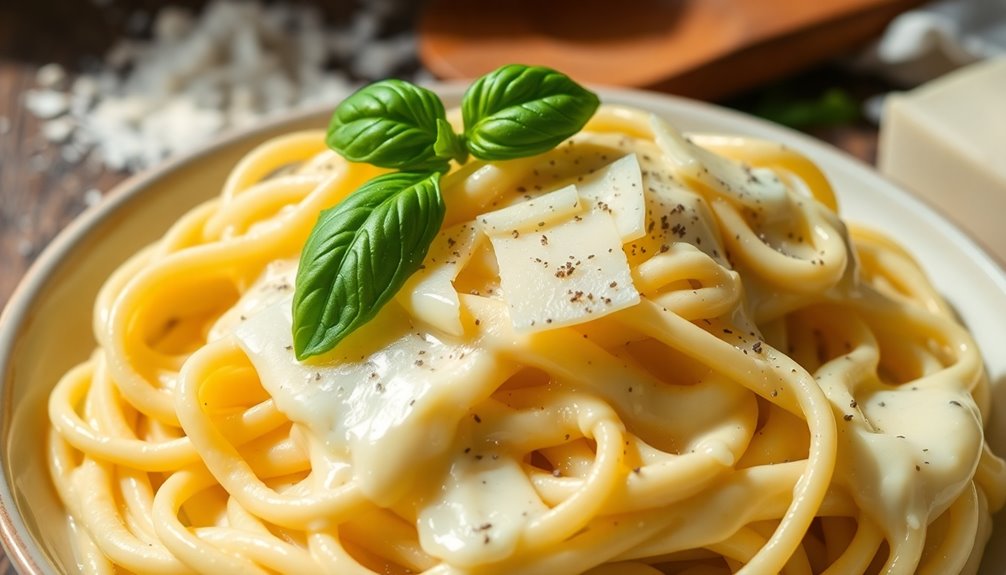
To start cooking your fettuccine, boil salted water in a large pot until it's bubbling.
Once you've added the fettuccine, you'll want to toss it with Alfredo sauce for that creamy goodness.
Finish off by mixing in Parmesan and a sprinkle of pepper, then serve it up with fresh parsley for a delightful presentation.
Step 1. Boil Salted Water

Start by filling a large pot with water and adding about 1-2 tablespoons of salt for every gallon. This salt enhances the flavor of the pasta as it cooks.
Next, place the pot over high heat and bring the salted boiling water to a rolling boil. It's crucial to have the water boiling vigorously so the fettuccine cooks evenly and doesn't stick together.
Once you've achieved a strong boil, you're ready to add the fettuccine. Stir gently to separate the noodles, ensuring they don't clump.
Cook the fettuccine for 4 to 5 minutes, checking for that perfect al dente texture—firm to the bite but cooked through.
Remember to reserve a cup of pasta water before draining!
Step 2. Add Fettuccine to Boiling Water
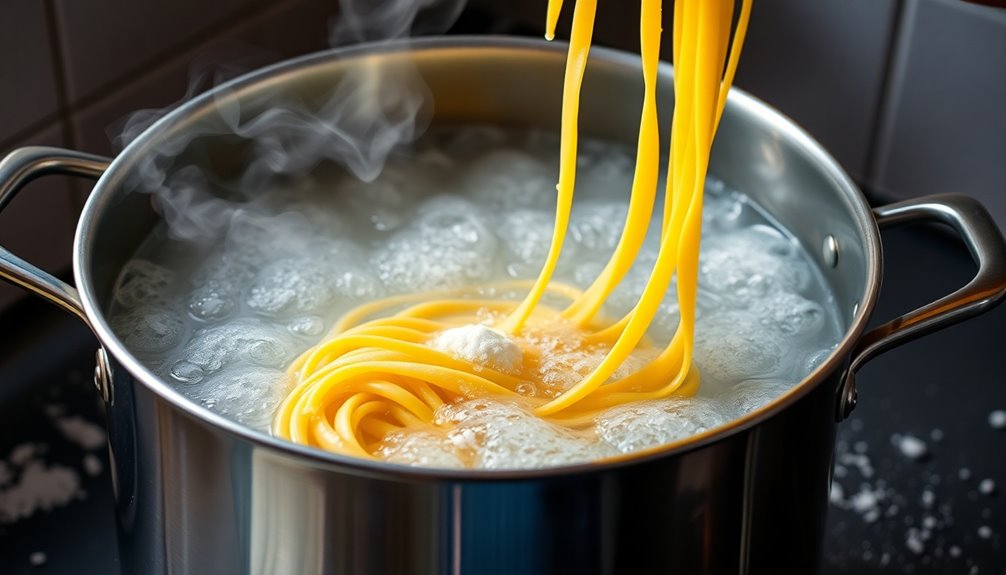
Once the water's boiling vigorously, it's time to add the fettuccine.
Carefully drop the noodles into the large pot, ensuring they're fully submerged.
Gently stir the fettuccine to separate the strands and prevent them from sticking together.
Cook it for about 4 to 5 minutes until it reaches that perfect al dente texture, firm to the bite.
As it cooks, remember to reserve a cup of that starchy pasta water before draining. This water is gold for later!
Once the fettuccine's cooked, drain it using a colander, but don't rinse it.
The residual starch on the noodles will help the sauce cling beautifully when you combine them later.
Enjoy the process!
Step 3. Toss With Alfredo Sauce

As you prepare to toss the fettuccine with Alfredo sauce, grab a large heatproof bowl and combine grated Parmigiano-Reggiano cheese with diced butter.
Once your pasta is cooked al dente, drain it but reserve some of the starchy cooking water.
Add the hot, drained fettuccine directly to the bowl with the cheese and butter. Pour in about half a cup of the reserved cooking water to help emulsify the sauce.
Use a large skillet or tongs to toss everything together until the butter melts and coats the noodles in a creamy sauce. Make sure the cheese is evenly distributed.
Serve immediately, optionally garnished with grated pecorino Romano and freshly ground black pepper for extra flavor.
Step 4. Add Parmesan and Pepper
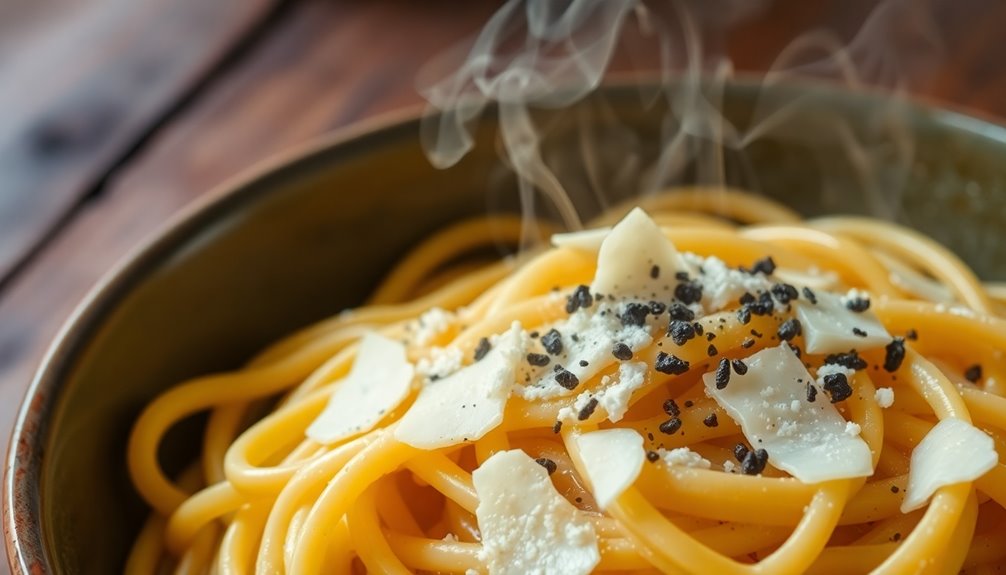
To create a rich and creamy fettuccine dish, you'll want to add the Parmigiano-Reggiano cheese and freshly cracked black pepper at just the right moment.
Start by heating half the butter in a skillet, then add a ladle of the reserved boiling pasta water. Once it's bubbling, toss in the drained fettuccine.
Gradually whisk in the finely grated Parmigiano-Reggiano, watching it melt and blend with the butter and pasta, creating that luscious creamy sauce you crave.
Don't forget to season generously with freshly cracked black pepper; it elevates the flavors and adds a delightful kick.
Serve your dish immediately, ensuring it's beautifully coated in sauce, and get ready for an authentic Roman experience.
Step 5. Serve With Fresh Parsley

While your fettuccine is still steaming, grab some fresh flat-leaf parsley to elevate the dish.
Finely chop the parsley and sprinkle it over your fettuccine Alfredo for a pop of color and a burst of freshness. The bright flavor of the parsley perfectly balances the richness of the butter and cheese, enhancing each bite.
Not only does it improve the presentation, but it also adds nutritional benefits, thanks to its vitamins and antioxidants. Additionally, incorporating ingredients rich in essential nutrients can further boost the healthiness of your meal.
Before serving, be sure to adjust the salt and pepper to taste, ensuring every element complements one another.
This simple step transforms your creamy pasta into a delightful meal that looks as good as it tastes.
Enjoy your beautifully finished fettuccine!
Final Thoughts

Fettuccine Alfredo stands as a testament to the beauty of simplicity in Roman cuisine. This classic pasta dish combines just a few high-quality ingredients: pasta, butter, and aged Parmigiano-Reggiano.
When prepared authentically, there's no cream or black pepper involved, allowing the rich flavors to shine through. The secret lies in using starchy pasta cooking water to emulsify the butter and cheese, creating that luscious, creamy sauce that clings to every noodle.
Authentic Fettuccine Alfredo relies on the magic of starchy pasta water to create a creamy, indulgent sauce without cream or pepper.
While Fettuccine alla Romana introduces bold elements like crispy pancetta and Pecorino Romano with black pepper, it's the purity of the original recipe that truly showcases Roman culinary artistry.
Enjoying this dish connects you to its rich history and the simplicity that defines great Italian cooking.
Frequently Asked Questions
Is Fettuccine a Roman?
Fettuccine isn't specifically a Roman dish, but it does have strong ties to Italian cuisine, particularly from Rome.
You'll find it often featured in various regional dishes. While it's characterized by its flat, ribbon-like shape, its origins are broader within Italy.
If you're exploring pasta, you'll discover that fettuccine serves as a versatile base for many sauces, whether rich and creamy or light and simple.
Enjoy experimenting with it in your cooking!
Does Rome Have Fettuccine Alfredo?
No, Rome doesn't have Fettuccine Alfredo as you might expect.
Instead, you'll find a dish called Fettuccine alla Romana, which features fettuccine tossed with butter, Pecorino Romano cheese, and black pepper.
This version highlights the rich flavors without the cream commonly found in American adaptations.
If you're in Rome, seek out this authentic dish for a true taste of local pasta rather than the Americanized version you're familiar with.
What Is the Translation of Fettuccine?
The translation of "fettuccine" in Italian means "little ribbons," which perfectly describes the pasta's flat, long shape.
You'll find that the name reflects both its appearance and its preparation method, derived from the verb "fettare," meaning "to slice."
This simple yet delicious pasta is typically made from flour and eggs, giving it a rich texture that pairs wonderfully with various sauces.
Was Fettuccine Alfredo Invented in Rome?
You might wonder if Fettuccine Alfredo truly originated in Rome.
The truth is, it was indeed invented there by Alfredo Di Lelio in the early 20th century. He created the dish for his wife to help her regain strength after childbirth.
This simple yet rich recipe, featuring fettuccine, butter, and Parmigiano-Reggiano, highlights the beauty of Italian cuisine.
Over time, it gained fame, but the roots remain deeply tied to Roman tradition.
